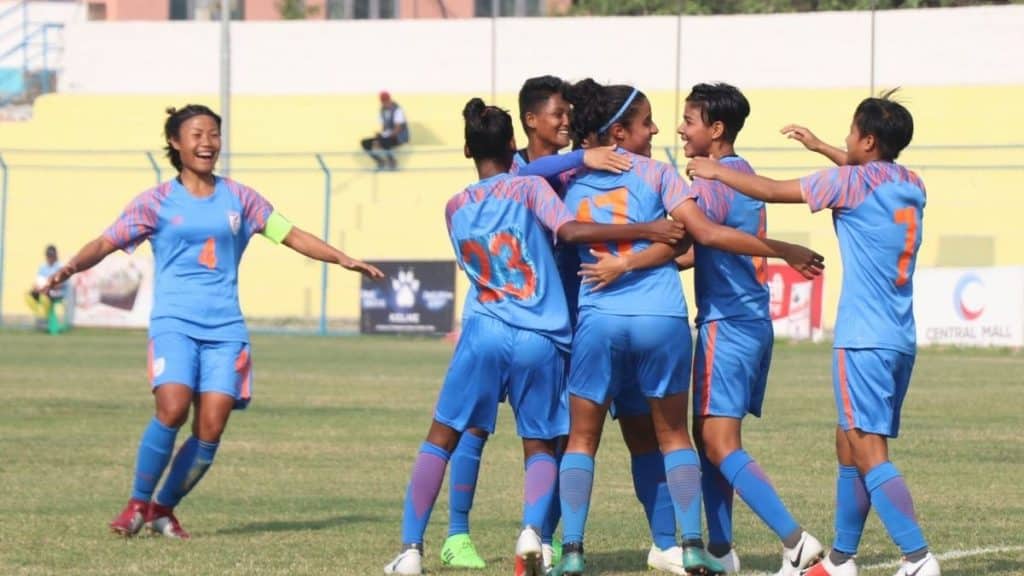Football- The Indian Women’s Team :
Football or Soccer as it is referred to in countries such as the USA, Canada, or Australia is the world’s most-watched and loved sport. It is the biggest sport on our planet not just in terms of viewership but revenues as well. More than 4 billion people watch football all around the year.
Other most popular sports such as NFL(National Football League which is better known as American Football and played more in a rugby-style than soccer) has 400 million fans, Baseball has 500 million fans, Table Tennis has 850 million fans, Tennis has 1 billion fans. Cricket, which is the most popular sport in India has a fan base of more than 2.5 billion. In fact, with 277 million Instagram followers Barcelona is the world’s most loved and followed club on social media. In terms of revenue, the Football industry is worth more than 38 billion dollars.
The itinerary of football is jam-packed all around the year through different professional leagues all around the globe. Be it the most competitive and lucrative English Premier League of England, La-Liga of Spain, Bundesliga of Germany, Ligue 1 of France, Serie A of Italy, MLS(Major League Soccer) of USA, Liga MX of Mexico, Primeira Liga of Portugal, Argentine Primera Division(the top division league of Argentina Football league system), Campeonato Brasileiro of Brazil.
Others include the Botola Pro football league of Morocco which is also considered the best football league in Africa, The Egyptian premier League of Egypt( The land of talismanic Mohamed Salah of Liverpool), The A-League of Australia, J1 league of Japan, Chinese Super League and India’s very own Indian Super League.
In comparison to big European, South American, or even Japanese or Chinese Leagues, the Indian Super League is at its nascent stage, to say the least. A top player from India in the ISL like Apulia(Lalengmawia Ralte), Liston Colaco, Manvir Singh, Asish Rai, Sandesh Jhingan, Sunil Chetri, Anirudh Thapa, Sahal, and Abdul Samad, or foreign recruits such as Hugo Boumous, Roy Krishna, Bartholomew Ogbeche, Bright Enobakhare, Cleiton Silva, and Igor Angulo earns between 60 lakh to 3 crore rupees per year.
Whereas an Algerian Player by the name of Riyad Karim Mahrez who plays as a right-winger for English Premier League club Manchester City earns close to 100 crore rupees per year. If you move to the far east in China, a player named Oscar from Brazil earns close to 200 crores per year in the now lucrative Chinese Premier League.
Recently iconic Argentine Superstar and perhaps the greatest football player on the planet Lionel Messi was bought by French Club Paris Saint Germain from Barcelona with a whooping 230 crores including add-on perks(salary of 25 million euros) per year. That’s how distant ISL and its players especially Indians are from their counterparts in other nations and leagues around the world.
Football is the sleeping giant of Indian Sports. It’s everywhere in the world. It has the power to catapult a nation to the legionnaires of the greatest sporting nations. China has learned it. That’s why China is investing heavily in Football with a vision and a mission to become the largest market for football and even nurturing the dream to host and win the coveted Football World cup within a decade or two.
China’s Supreme leader Xi Jinping’s dream which is “ Implementing the Chinese dream of the glorious revival of the Chinese Nation is intricately linked with the dream of China becoming a football powerhouse.”. China’s football development plan includes:
- to build 16 to 20 Football cities by 2025
- 2 prestigious clubs per city and 1 youth training center
- 20000 football training centers
- 70000 football pitches
- Football courses in all elementary schools with a mission to generate 30 million children playing the sport.
- Providing a vibrant Football market so that top clubs of Europe such as Bayern Munich, Barcelona, Real Madrid, Manchester United, Juventus tap the humongous fan base that China has to offer and generate revenue through merchandising sponsorship, and broadcasting.
- Become a top Asian team by 2030 and eventually host and win the Football World cup by 2040.
Indian Football was at its peak during the late 1940s to mid-1960s as India played in four Olympics and won two Asian Games gold medals. It was the golden era of Indian football as they were ranked among the top 20 teams in the world. Let no one forget the heroism of PK Banerjee, Chuni Goswami, Tulsidas Balaram, Sailen Manna, Jarnail Singh, Peter Thangaraj.
Subimal Goswami, who was popularly known as Chuni was the poster boy of Indian Football. A top-class footballer with exceptional dribbling, ball passing, and ball control skills he was reportedly approached by English top tier club Tottenham Hotspur for trials after his accomplishments at the 1962 Jakarta Asian games where he captained the team to a gold medal finish after famously defeating Asian giants South Korea, but he turned down the offer of the rich London club to stay loyal to his club Mohun Bagan.
Today our Indian men’s football team FIFA rankings is a disappointing 104. Although they have managed to improve their ranking from 143 since 1992 when the first official FIFA rankings were rolled out but to believe that this is the best that Indian football can offer is not acceptable.
India is still considered a one-nation sport even though Neeraj Chopra’s brilliance at the recently concluded Tokyo Olympics where he managed to secure a Gold medal in Javelin is slowly but surely pulling youngsters to different Olympic sports especially athletics, boxing, shooting, archery, badminton, wrestling, and weight lifting.
What Indian football needs right now is a spine-chilling, unforgettable performance by the national team at major International events even if they are friendlies with high-ranked countries to awaken the dormant giant. This is where the forthcoming AFC Women’s Asian Cup 2022 scheduled to be held in New Delhi from 20th January to 6th February could be the game-changer in Indian Football.
With Iran, Chinese Taipei, and China in the same group India will be looking desperately to qualify for the semi-finals spot. And if they manage to enter the semi-finals then India will make history by directly qualifying for the very first time in the 2023 FIFA Women’s World Cup scheduled to take place in Australia and New Zealand from 20th July to 20th August 2023.
Ranked 55th in the world, The Women’s national team is improving much faster than the men’s with some terrific performances in recent memory, one of which is traveling to Brazil to participate in a 4 nations cup involving football powerhouses such as Brazil, Venezuela, and Chile.
Although they didn’t manage to win a single game but the exposure has given them the confidence and the self-belief which is the need of the hour. The Star-Studded Indian football team has fantastic players like Aditi Chauhan, Dalima Chhibber, Grace Dangmei, L Ashalata Devi, Manisha Kalyan( the one and only warrior who scored the single goal against Brazil), N Sweety Devi, Pyari Xaxa, Manisha Panna, Indumathi Kathiresan, Sanju Yadav, Anju Tamang, M Linthoingambi Devi among others.
The Women’s national team can take inspiration from the defending Asian Champions Japan who fought against all odds including massive devastations from earthquakes and tsunamis and the subsequent nuclear disaster at the Fukushima Daiichi Nuclear Power Plant which claimed close to 20000 lives just 4 months before the 2011 Football world cup in Germany to gift their nation a moment of joy, respite, and a much-needed relief by defeating the mighty USA in the world cup finals and ending the monopoly of the Americans and the Europeans.
In an incident just before the quarter-final clash against host Germany, the diminutive Japanese players were apprehended by the sheer average height of German footballers which was 6 feet and 2 inches. Desperate times call for desperate measures. For Japan, they didn’t have to look too far to find inspiration to perform out of their skins.
According to a report in THE GUARDIAN, Coach Norio Sasaki showed them the footage of the disaster before their game against Germany. It did the trick as Japan beat the Germans 1–0 in extra time. Apart from their craft and skills, Japan displayed a lot of grit and an appetite to fight. In that game, Japan received four yellow cards, a rarity for the team. They were playing with more fire and bite.
Captain Homare Sawa, the inspirational leader, is considered to be the greatest Japanese women’s player of all time. During the extra time in the finals against the USA, Japan was trailing 2–1. In the 117th minute with the clock ticking away against Japan, Sawa made an intelligent run to the near post.
The corner came at an awkward height for her but she managed to get her leg up and glance it in at the near post. Hailed by many as the greatest goal in Women’s world cup history, got Japan level at 2–2. The final went into a penalty shootout and the rest as they say is history. The USA never recovered from that late equalizer by Sawa and Japan went on to become the first Asian team to win a FIFA event at any level.
Anything is achievable if one has the confidence and the self-belief in his or her dreams. Let’s hope and pray together for the success of our BLUE TIGRESSES.
INDIA A SPORTING POWERHOUSE IS NOT JUST A DREAM ITS A MISSION TO ACCOMPLISH.
If you wish to have a career in the sports industry then you are at the right place.. At Mad About Sports we have multiple courses that could guide you to having a career in the sports industry. To learn more about Sports Analytics and other careers in the Sports industry visit : https://madaboutsports.in/
More on the Indian Women’s Football team : https://twitter.com/womensfootieind?lang=en



